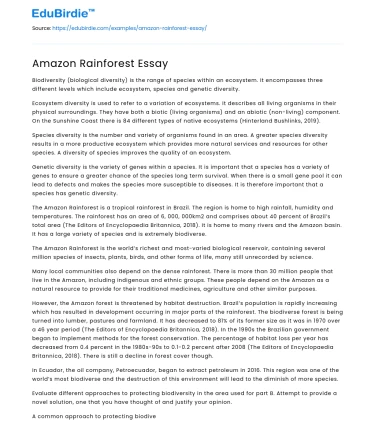Biodiversity (biological diversity) is the range of species within an ecosystem. It encompasses three different levels which include ecosystem, species and genetic diversity.
Ecosystem diversity is used to refer to a variation of ecosystems. It describes all living organisms in their physical surroundings. They have both a biotic (living organisms) and an abiotic (non-living) component. On the Sunshine Coast there is 84 different types of native ecosystems (Hinterland Bushlinks, 2019).
Save your time!
We can take care of your essay
- Proper editing and formatting
- Free revision, title page, and bibliography
- Flexible prices and money-back guarantee
Species diversity is the number and variety of organisms found in an area. A greater species diversity results in a more productive ecosystem which provides more natural services and resources for other species. A diversity of species improves the quality of an ecosystem.
Genetic diversity is the variety of genes within a species. It is important that a species has a variety of genes to ensure a greater chance of the species long term survival. When there is a small gene pool it can lead to defects and makes the species more susceptible to diseases. It is therefore important that a species has genetic diversity.
The Amazon Rainforest is a tropical rainforest in Brazil. The region is home to high rainfall, humidity and temperatures. The rainforest has an area of 6, 000, 000km2 and comprises about 40 percent of Brazil’s total area (The Editors of Encyclopaedia Britannica, 2018). It is home to many rivers and the Amazon basin. It has a large variety of species and is extremely biodiverse.
The Amazon Rainforest is the world’s richest and most-varied biological reservoir, containing several million species of insects, plants, birds, and other forms of life, many still unrecorded by science.
Many local communities also depend on the dense rainforest. There is more than 30 million people that live in the Amazon, including indigenous and ethnic groups. These people depend on the Amazon as a natural resource to provide for their traditional medicines, agriculture and other similar purposes.
However, the Amazon forest is threatened by habitat destruction. Brazil’s population is rapidly increasing which has resulted in development occurring in major parts of the rainforest. The biodiverse forest is being turned into lumber, pastures and farmland. It has decreased to 81% of its former size as it was in 1970 over a 46 year period (The Editors of Encyclopaedia Britannica, 2018). In the 1990s the Brazilian government began to implement methods for the forest conservation. The percentage of habitat loss per year has decreased from 0.4 percent in the 1980s-90s to 0.1-0.2 percent after 2008 (The Editors of Encyclopaedia Britannica, 2018). There is still a decline in forest cover though.
In Ecuador, the oil company, Petroecuador, began to extract petroleum in 2016. This region was one of the world’s most biodiverse and the destruction of this environment will lead to the diminish of more species.
Evaluate different approaches to protecting biodiversity in the area used for part B. Attempt to provide a novel solution, one that you have thought of and justify your opinion.
A common approach to protecting biodiversity is the inclusion of protected areas such as national parks where an area of land cannot be developed, and the environment is protected. Similar methods have been implemented in the amazon forest before. In the 1990s, efforts were began to protect the forest from destruction by the Brazilian government and other international bodies. This allowed for the rate of loss to decline.
There was also an attempt to preserve a part of the forest in Ecuador. The government agreed to not extract oil deposits at a estimated value of 7.2 billion on the basis that other countries and private donors would contribute half the value of the oil to a UN trust fund. This plan was unsuccessful with Ecuador extracting oil in 2016 after not enough money was raised.






 Stuck on your essay?
Stuck on your essay?

